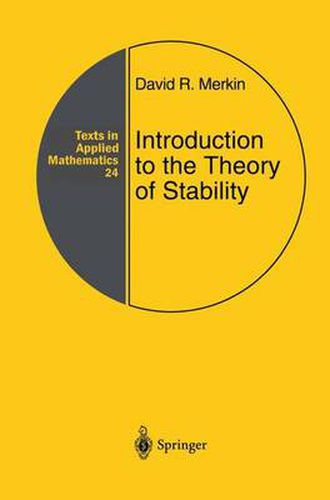Readings Newsletter
Become a Readings Member to make your shopping experience even easier.
Sign in or sign up for free!
You’re not far away from qualifying for FREE standard shipping within Australia
You’ve qualified for FREE standard shipping within Australia
The cart is loading…






This title is printed to order. This book may have been self-published. If so, we cannot guarantee the quality of the content. In the main most books will have gone through the editing process however some may not. We therefore suggest that you be aware of this before ordering this book. If in doubt check either the author or publisher’s details as we are unable to accept any returns unless they are faulty. Please contact us if you have any questions.
Many books on stability theory of motion have been published in various lan guages, including English. Most of these are comprehensive monographs, with each one devoted to a separate complicated issue of the theory. Generally, the examples included in such books are very interesting from the point of view of mathematics, without necessarily having much practical value. Usually, they are written using complicated mathematical language, so that except in rare cases, their content becomes incomprehensible to engineers, researchers, students, and sometimes even to professors at technical universities. The present book deals only with those issues of stability of motion that most often are encountered in the solution of scientific and technical problems. This allows the author to explain the theory in a simple but rigorous manner without going into minute details that would be of interest only to specialists. Also, using appropriate examples, he demonstrates the process of investigating the stability of motion from the formulation of a problem and obtaining the differential equations of perturbed motion to complete analysis and recommendations. About one fourth of the examples are from various areas of science and technology. Moreover, some of the examples and the problems have an independent value in that they could be applicable to the design of various mechanisms and devices. The present translation is based on the third Russian edition of 1987.
$9.00 standard shipping within Australia
FREE standard shipping within Australia for orders over $100.00
Express & International shipping calculated at checkout
This title is printed to order. This book may have been self-published. If so, we cannot guarantee the quality of the content. In the main most books will have gone through the editing process however some may not. We therefore suggest that you be aware of this before ordering this book. If in doubt check either the author or publisher’s details as we are unable to accept any returns unless they are faulty. Please contact us if you have any questions.
Many books on stability theory of motion have been published in various lan guages, including English. Most of these are comprehensive monographs, with each one devoted to a separate complicated issue of the theory. Generally, the examples included in such books are very interesting from the point of view of mathematics, without necessarily having much practical value. Usually, they are written using complicated mathematical language, so that except in rare cases, their content becomes incomprehensible to engineers, researchers, students, and sometimes even to professors at technical universities. The present book deals only with those issues of stability of motion that most often are encountered in the solution of scientific and technical problems. This allows the author to explain the theory in a simple but rigorous manner without going into minute details that would be of interest only to specialists. Also, using appropriate examples, he demonstrates the process of investigating the stability of motion from the formulation of a problem and obtaining the differential equations of perturbed motion to complete analysis and recommendations. About one fourth of the examples are from various areas of science and technology. Moreover, some of the examples and the problems have an independent value in that they could be applicable to the design of various mechanisms and devices. The present translation is based on the third Russian edition of 1987.